Melbourne After Dark: Discover the City’s Most Haunted Locations
Nestled within Melbourne’s bustling streets and storied landmarks, tales of restless spirits and eerie apparitions abound.
Beneath the city’s lively facade lies a tapestry of 19th-century tragedies and mysteries that linger in the shadows.
From the creaking corridors of colonial jails to the lamp-lit alleys of its old port, Melbourne’s most haunted places invite brave visitors to step back in time.
In these narratives of each haunt, we follow the flicker of gaslight and the whisper of history, sharing chilling local legends and eyewitness accounts – along with practical tips on how to visit each site safely (often via public tours or museums).
Prepare to be creeped out as we explore the macabre charm of Melbourne’s ghostly hotspots.
Old Melbourne Gaol
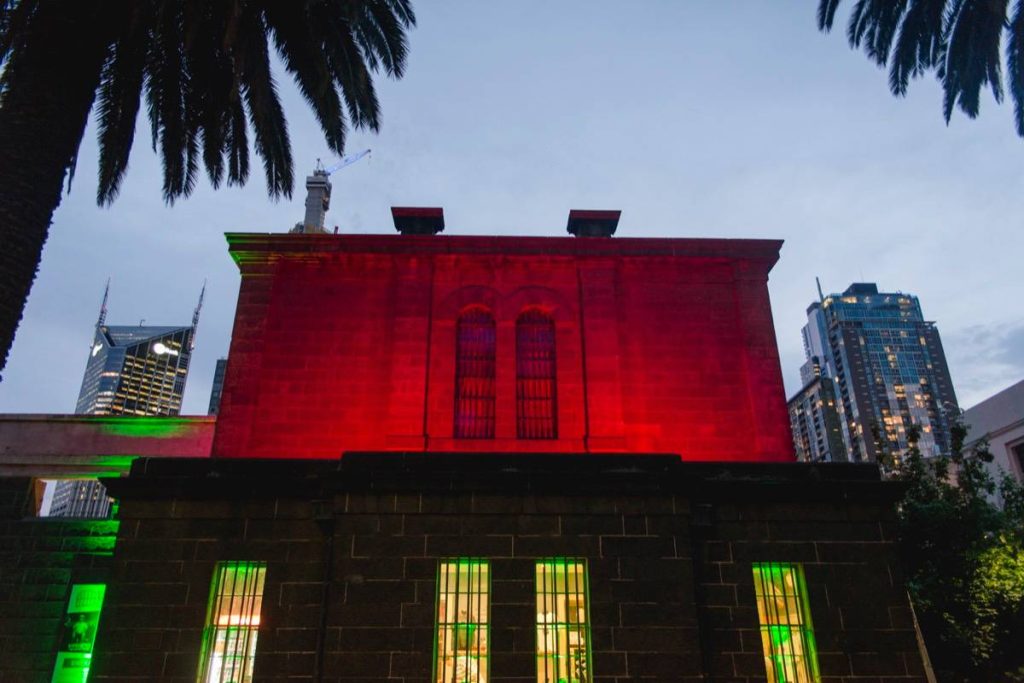
Above the roar of trams and traffic, the hulking bluestone walls of the Old Melbourne Gaol harbour over a century of anguish.
This grim fortress (1842–1929) saw 133 executions – including the infamous bushranger Ned Kelly – as well as countless deaths from disease and despair.
Guides say those “really negative” events have left a supernatural residue here.
In Cell 17 on the middle floor, countless visitors have felt unseen hands grasping at their throats or tugging at their coats.
In one harrowing account, a tour-goer stepped into Cell 17 and felt a sudden tug at the nape of her neck just as she tried to leave – at the very moment the chain on her necklace inexplicably snapped in two.
Staff even advise (half-jokingly) that if you enter Cell 17, you should never close the door behind you, lest you trap yourself with whatever may lurk inside.
Despite its sinister reputation, the Gaol is open daily as a museum, offering a range of tours.
By day, you can wander the stone corridors and tiny cells, but at night, the gaol provides candlelit ghost tours, exposing visitors to “bone-strumming” tales of the paranormal.
Daredevils can book the “Ned Kelly’s Last Stand” tour or the “Ghosts? What Ghosts?” night tour on weekends.
The sense of history is palpable: one guide quipped that places marked by suffering inevitably seem to manifest ghosts, and this jail was “definitely a real hub of cruelty”.
For those eager to test the legends, the gaol stands just north of Melbourne’s CBD on Russell Street – easily visited by tram – and with lantern tours lasting into the wee hours, it’s the premier spot for ghost hunters seeking a chilling thrill in a museum setting.
Princess Theatre
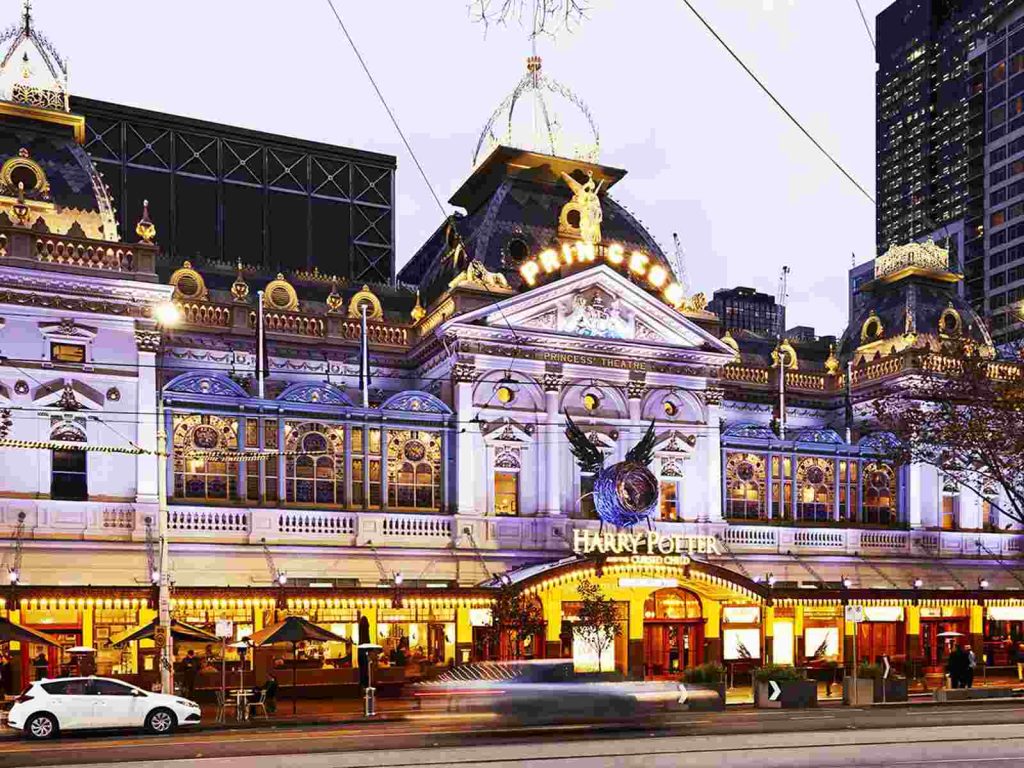
Constructed in 1854, Melbourne’s grand Princess Theatre hides a famous friendly spectre.
During the final curtain call of Faust in 1888, the opera singer Fredrick Federici (often called Baker or “Fredrici”) suffered a fatal heart attack while being lowered through a trapdoor onstage.
The audience and actors were unaware of his death; amazingly, they later swore that Federici had been onstage with them, taking bows.
To this day, stagehands report flickering lights and sudden goosebumps during curtain calls, as if something (or someone) extra is sharing the applause.
Tradition even holds that a seat in the dress-circle is always reserved for Federici on opening nights, an unspoken invitation to “take a bow” if his spirit returns.
Some staff and actors claim to see a refined gentleman from the 1880s dressed in a tailcoat, sometimes seated in the audience, watching performances with peculiar interest.
Today, the theatre still stages major shows, so the best way to sense its ghosts is to attend a performance and linger in the historic foyer.
Tours also visit the elegant 1854 interiors (including plush balconies and marble staircases) where Federici’s presence is most often felt.
For a spine-tingling experience, ask about the “Phantom of the Opera” lore when you book, or simply catch the next show and keep an eye out during the final bow.
If you’re brave, stop by the adjacent Hotel Windsor (built 1884) after the show.
This grand old hotel also has its own apparitions, notably the famed soprano Dame Nellie Melba, whose ghostly arias are said to drift down the corridors at night.
Between the theatre and the hotel, you can plan an entire haunted evening: theatre tickets plus a night at the Windsor, where ghost stories and history entwine.
Queen Victoria Market
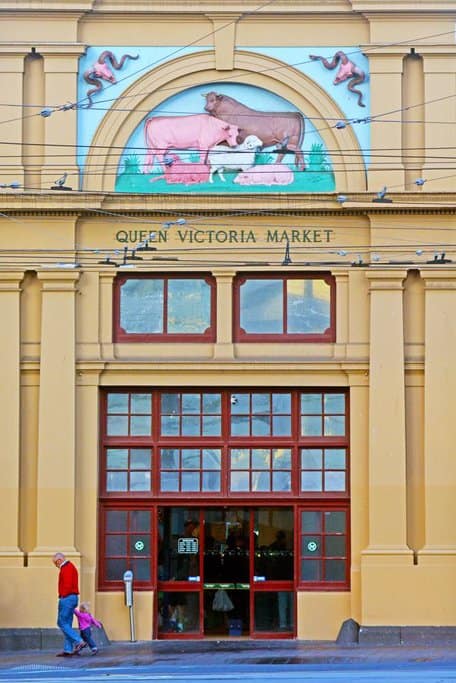
By day, the Queen Victoria Market hums with crowds and commerce – but by night its shadows grow thick.
Melbourne’s largest open-air market (established 1878) was built atop the city’s old cemetery. Nearly 9,000 bodies were never exhumed before development.
This includes the unremarked remains of convicts and Aboriginal people.
Locals claim the restless spirits of those early settlers still haunt the market lanes.
Vendors and after-hours cleaners have reported inexplicable cold spots, phantom footsteps, and the sensation of being followed or brushed past by unseen shoppers.
Some say the most haunted area is near the old fruit-and-vegetable hall; here at night, a stranger might suddenly feel a chill or pressure on the shoulder as if bumped by someone who isn’t there.
A grinning ghost of a bushranger and even Aboriginal spirits are part of market lore, though most restless presences remain anonymous.
You can stroll the market for free at any time; it’s open most mornings (except Wednesday and Saturday) and into the evening on certain days.
For a true thrill, several guided ghost tours will take you through the fruit hall by torchlight, when eerie noises and the weight of history seem stronger.
Tour guides highlight the rows of unmarked graves beneath your feet and retell stories of excited children in the jam doughnut queue suddenly feeling a cold breeze that wasn’t there.
Even without a formal tour, a late-night wander through the silent, closed market can send shivers up your spine – just mind the stray vagrant or two who also haunt its stalls after midnight.
Abbotsford Convent
Today, a hive of cafés, galleries and green lawns, Abbotsford Convent was once a stern Magdalen asylum for “fallen” girls (1863–1975) run by nuns.
The convent’s long corridors, convent chapel and old laundry rooms are said to echo with the sorrow of past residents.
Many visitors and resident artists report hearing mysterious footsteps, sniffing or crying sounds, and doors that creak on their own at night.
One guide claims the silent, empty laundry building can feel “creepy” late in the day – some believe the labouring girls left behind psychic imprints in that space.
The belief is so widespread that the Convent runs its own ghost tours each month, and even a local podcast (“The Abbotsford Mysteries”) explores the site’s haunted history.
If you visit by day, it’s hard to imagine the convent’s original, harsher purpose.
But as you wander the pretty grounds, remember it was home to many troubled or abused young women, and their presence is palpable to believers.
The convent is freely open to the public (no entrance fee) and offers tours through its chapels and cloisters.
For a genuinely eerie experience, join one of the guided twilight or lantern tours – some have spotted a pale figure gliding along the cloister at dusk.
Otherwise, the Convent’s gardens and art spaces remain welcoming in daylight; just be mindful that you share the history with those who might not have left.
Hosier Lane

Hosier Lane is famous for its ever-changing street art, but at night it can feel ominous and cold.
Locals warn of the ghost of Frederick Bailey Deeming, a 19th-century conman and suspected murderer who was hanged at Pentridge Prison in 1892.
Legend says Deeming (rumoured by some to have been an early “Jack the Ripper” suspect) sometimes lingers in the graffiti-covered alleys.
People walking along Hosier Lane after dark have reported the sensation of icy hands on their necks or shoulders, accompanied by a sudden, overwhelming dread.
Tourists, especially men, claim to feel cold fingers brush the back of their necks, as if the cruel Deeming still prowls his old Melbourne haunts.
You can visit Hosier Lane anytime (it’s a public laneway just off Flinders Street).
To experience the full ghost story, consider a guided laneway tour, which often recounts the Deeming legend under the light of torches.
But even solo: stride past the murals under the echo of distant night traffic, and you might catch a chill breath on your skin. (If nothing else, just enjoy the art – but maybe keep moving after midnight, just in case!)
Luna Park, St Kilda
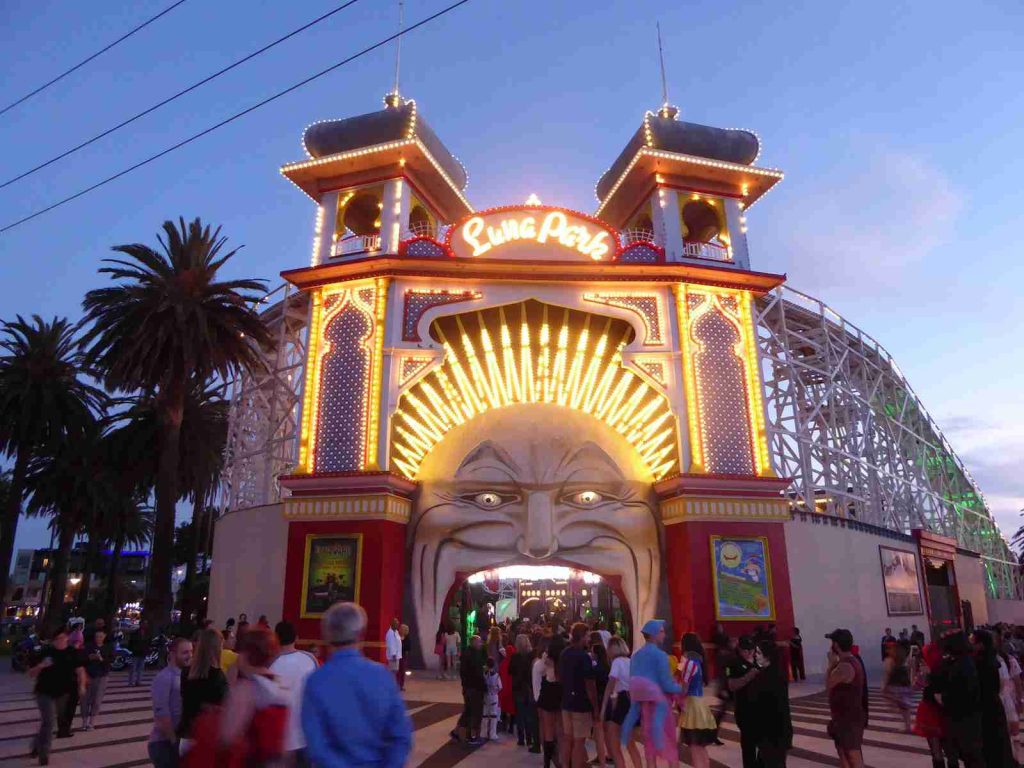
Along St Kilda’s foreshore, Luna Park amusement park (1912–present) hides its own spectral fun.
Melbourne’s Luna Park has a slightly sinister wrinkle beyond its clown face façade. Storytellers say a ghost known as the “Joker” haunts the ride platforms.
He is described as a grinning carnival spirit who appears on the vintage Scenic Railway rollercoaster and the Ferris wheel late at night.
No one knows who he was in life – perhaps a jester or a doomed ride operator – but riders have reported feeling watched and seeing a ghostly silhouette in the night sky above the park’s lamplights.
While the park is very much family-friendly during the day, the mystery of the Joker adds a thrill for the brave.
Luna Park is open year-round, and after dark, one sometimes hears a solitary ghostly laugh echoing through the empty games hall – though it’s probably just the cleaning staff.
To fully chase the legend, join one of the occasional haunted Luna Park tours (often run in October), or simply take a ride at night (if the park is open late) and stare into the darkness.
Keep an ear out, though: in broad daylight the park’s crowds will likely drown out any ghostly whispers, so the real fun is to visit on a quiet evening and see if that Joker shows his face.
The Mitre Tavern
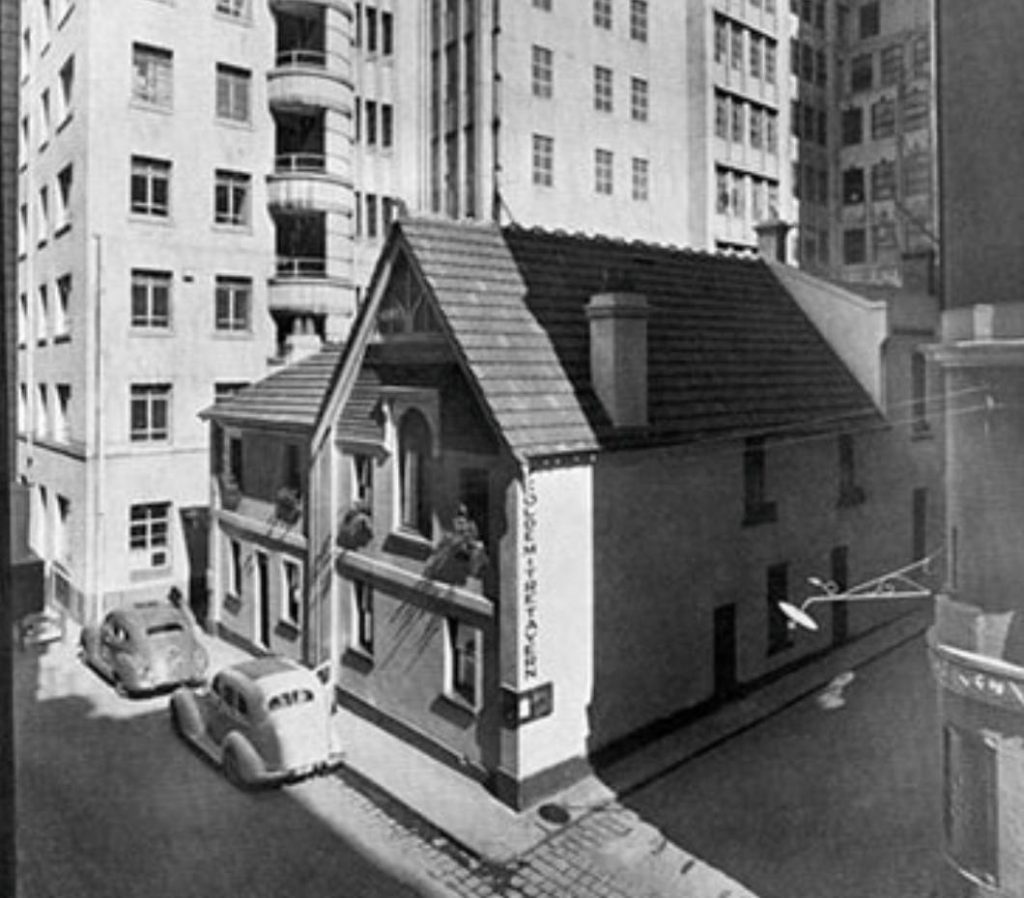
Built in 1867, the Mitre Tavern on William Street claims the title of Melbourne’s oldest pub.
Inside its cosy bar and upstairs balcony lurks a local ghost: Connie Waugh, the mistress of a wealthy landowner, Sir Rupert Clarke.
The story goes that Connie – heartbroken by tragedy – hanged herself inside the tavern’s walls in Victorian times.
Staff and patrons have occasionally glimpsed a pale woman in white drifting on the balcony or swaying near the windows.
Some regulars say they can hear soft sobbing late at night when the pub is empty.
Today, the Mitre is a popular Irish-style pub with hearty meals, but a visit here comes with a flair of the uncanny.
If you sit on the upper balcony or order a pint near the old fireplace, watch for a sudden cold draft or movement in the corner of your eye.
The ghost is said to be mainly mournful, not malicious – though none are eager to test the theory by popping in after midnight alone.
The tavern welcomes all comers at any hour, so you can raise a glass in Connie’s honour.
Frequent ghost tours also pass by the Mitre, highlighting it as a stop.
When you visit, tread lightly on the stairs and maybe buy an extra round – you might just find the pub’s oldest patron watching you from above.
Hotel Windsor
Stepping out of the Mitre and walking across the street brings you to another classic haunt: the Hotel Windsor (erected in 1884).
This grand edifice has hosted royals and opera stars, and rumour has it that a few refuse to leave.
The most famous tale involves Dame Nellie Melba, Australia’s beloved soprano, who once stayed here.
Guests report that late in the evening they can hear faint operatic singing drifting down the hallways – as if Nellie is still practising in Room 501.
In dim light, staff have seen a lady in formal Edwardian dress gliding towards the elevator.
Some say the source is a performer’s regret: Melba was actually delayed by the stage at the theatre next door, but the hotel was expecting her, so she never arrived that night – perhaps her spirit was left wandering the hall.
Guests can book a night at the Windsor and see if they catch any spectral music.
The bar and lobby (with its wood panels and embroidered carpets) have no shortage of period ambience; just keep an ear open after midnight.
The Windsor also routinely offers historic tours, which mention its ghost story as a selling point.
If you prefer, slip into the bistro – named Federici’s after the Princess ghost – and raise a quiet toast to all the past performers, both living and lost, who still linger in this corner of Melbourne’s theatre district.
Williamstown Ghosts
A short ferry ride or suburban train west of the city lies Williamstown, the Victorian colony’s original port.
By lamplight, its narrow streets are one of Melbourne’s newest ghost tours – the “Ghosts of the Old City” tour.
Williamstown’s heyday (mid-1800s) saw drunks, sailors and ex-convicts roaming its pubs and docks, and local legends say a few never checked out.
Guides will lead you past the city’s oldest morgue, dilapidated burial grounds and hidden alleys, sharing tales of phantom ships on Hobsons Bay and spectral women in mourning dresses.
One story tells of a shadowy figure seen in the Botanic Gardens at night, still waiting for an offshore boat that never returned.
Another notes how the lamps in certain pubs flicker inexplicably, even when switched on.
Tours depart from Williamstown each Friday and Saturday night, or you can wander on your own.
The town is quite safe, but a lamp-lit walking tour led by Lantern Ghost Tours is the best way to hear the full stories.
In daylight, Williamstown is a normal seaside suburb; at nightfall, it seems to remember its seedier past, perfect for anyone wanting to end their ghost hunt by the harbour.
The tour even offers a dinner package, so you can dine in a tavern that itself dates to colonial times – and who knows, maybe encounter an extra guest at your table who isn’t on the menu.
The Wrap-Up
Each of these places is not only rich in spooky atmosphere but also open to brave visitors.
Whether you take an official ghost tour or simply wander the old halls and laneways at night, Melbourne’s past feels hauntingly alive.
Bring a jacket (it gets chilly after dark!), a flashlight for shadowy corners, and a healthy respect for history – and you might just bump into one of the city’s long-gone residents.
